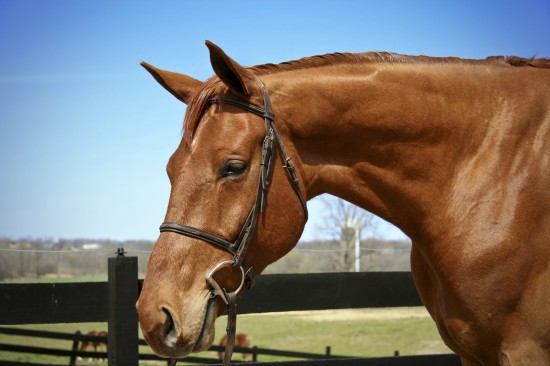

It can be very frustrating when a horse refuses to give to the bit and continually pulls back when you ask for their head. Many riding school ponies are great at ignoring any sort of rein aids which and this includes steering and stopping which is all due to the fact they have developed hard mouths!
Although many horses develop callouses on the corners of their mouths which makes it that much harder for them to "feel" rein aids, the problem of a hard mouth has to be seen as not only a physical issue but as a psychological one too. The reason being that many horses have learnt to resist the bit rather than anything else and it's in a horse's nature to resist pressure.
It's in a horse's nature to resist any pressure and many trainers believe that it's a failure to teach a horse to "give to pressure" that results in them becoming hard mouthed. Horses learn to pull against the bit if they are not taught to "give in" and the problem is made worse when people think the solution is to put the horse is a more severe bit.
The trouble being you soon run out of options as the horse gets used to each of the stronger bits that are placed in their mouths which they quickly learn they can still lean into. A stronger more severe bit should only be seen as a temporary "fix" because it will only be effective for a limited time. The end result is that both rider and horse get stuck in a never ending vicious circle with no long-term improvement in sight.
When it all comes down to it, many professional trainers know that a horse develops a hard mouth through poor training followed by poor riding skills which includes the overuse of hands. Horses quickly learn things and this includes the "bad", so if they lack the correct training, more often than not they don't respond to a rider's leg or seat which is the start of a "hard mouth" problem.
All too often riders rely too much on their reins to control a horse instead of using their legs and seat to achieve the same and much better result. This is a common problem for novice riders because using the reins and their upper bodies gives them the impression of being more in control of the horse which is in fact not true at all.
The result is that horses learn to resist the bit which makes them that much harder to ride. A hard mouthed horse will typically do the following:
In fact, a hard mouthed horse is only protecting themselves from any pain they might feel from the pressure of a bit or even the pressure they feel on their nose and chin when ridden in a hackamore. It's their defence mechanism against pain and all too often a rider will respond by increasing the pressure on their reins which just makes things worse.
Horses that run through the bit or bridle usually end up being heavy on the forehand and they lack the much needed drive from behind which helps them respond correctly to any correct aids they are given. They also either overflex or not flex at all at the poll and neck. When a horse overflexes, they learn to use their necks and mouths to pull the reins in a rider's hands which often makes a rider lean back and pull on their reins even harder which puts a lot of pressure on a horse's mouth.
It is not impossible to fix a hard mouth problem because with very careful retraining, a horse's mouth can be softened. The best way to start a retraining programme is to go back to basics. This includes lots of bending work which young horses are taught when they are first backed.
Horses need to be put in a snaffle and you need to find out if they know what "whoa" actually means. If a horse does not understand this basic verbal aid, then it's the first thing they need to be taught in their retraining programme. Once they understand what whoa means which can take a bit of time, the next stage is to get them "soft" at the walk which can be achieved by asking the horse to walk in a circle following his nose.
It is at this stage that a horse can be taught to bend but only very slowly and gently to begin with. Once a horse starts to respond you can ask a little more of them, but you should never try to rush things. Circles need to be kept smallish at this stage of the game and only when a horse starts to give and bend should they be asked to work in larger circles. However, it's essential the command "whoa" is used throughout these sessions to reinforce their training.
Once a horse feels comfortable and is bending nicely in a circle, the work needs to be repeated in a straight line before asking them to counter-bend, all the while rewarding them for giving to the bit. These sessions should never be rushed because you have to expect retraining to take time and a lot of patience. The reason being it can take horses a long time to trust there is no pain involved when a bit is placed in their mouths.
Copyright © 2005-2016 Pet Information All Rights Reserved
Contact us: www162date@outlook.com